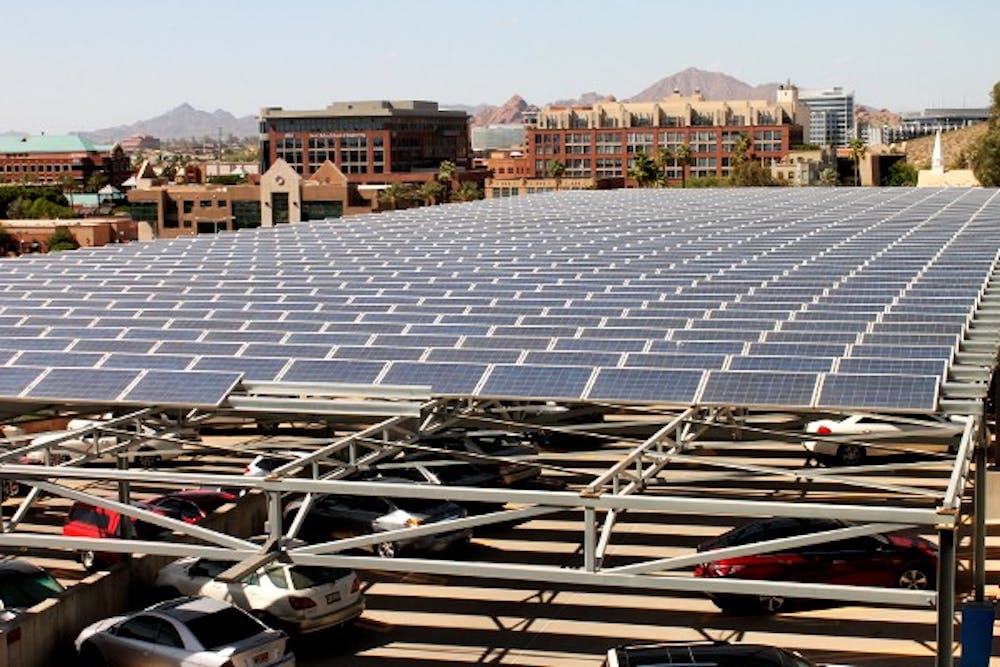 Solar panels top many parking garages, buildings and other structures around ASU's campuses, like the 10th Avenue lot seen here. For the past couple of years, solar energy has had a large impact on power at ASU. (Photo by Laura Davis)
Solar panels top many parking garages, buildings and other structures around ASU's campuses, like the 10th Avenue lot seen here. For the past couple of years, solar energy has had a large impact on power at ASU. (Photo by Laura Davis)
A photovoltaic power plant that opened earlier this month at the Polytechnic campus has added a megawatt to ASU's solar power capabilities, and additional installations this year will bring the University within two megawatts of its long-term solar goals.
The Salt River Project and SunPower Corp., a solar panel manufacturer, dedicated the plant on April 8.
The plant is the first to feature a new technology from SunPower that will track the sun and multiply its rays seven times to increase power while decreasing cost. The technology will provide research opportunities for students and faculty at the Polytechnic campus.
SunPower will generate electricity and sell it to SRP, and ASU will buy the electricity from SRP.
John Hetrick, who manages sustainability policy and programs at SRP, said the company plans to produce 20 percent of its energy from sustainable sources by 2020 and 10 percent of its energy sustainably by the end of the year.
“We’ve been actively involved with including solar into our portfolio," Hetrick said.
He said the last solar project SRP completed was a 19-megawatt solar farm in Queen Creek.
SRP is looking forward to partnering with ASU on the new technology at the Polytechnic plant, Hetrick said, adding that the company does not have another partnership similar to the one it has with ASU.
“ASU is unique in that we are working together to test a new technology,” he said. “We’re very intrigued by this technology.”
ASU’s embrace of solar power at all four campuses speaks to the University’s commitment to neutralizing its carbon emissions with sustainable energy, Hetrick said.
The University wants to achieve total carbon neutrality by 2025, said Dave Brixen, associate vice president for Facilities Development and Management and head of the campus solarization program.
Part of this goal is having a total solar power production capability of 25 megawatts by 2015, Brixen said.
The large amount of sunlight Arizona receives is a major reason why the University has chosen to invest in solar, he said.
“It just makes good sense to try to harness some of that energy,” Brixen said.
ASU has installed 19.7 megawatts of solar power across all four campuses and the research park, he said.
Most of this is generated at the Tempe campus, which has a capability of 12.7 megawatts, and ASU will have a capability of 23.4 megawatts by the end of 2013, Brixen said.
He said fulfilling the goal of 25 megawatts by 2015 is the biggest challenge for ASU’s sustainable energy at the moment, even though it will be close to completion by the end of this year.
The University has limited amounts of space remaining for panel installations, he said. At the same time, ASU does not want to overshoot its goal.
“That’s probably our biggest challenge right now,” Brixen said. “We don’t want to install so much solar that we’re selling back into the grid.”
Solar is an energy resource with increasing future potential, said Stephen Goodnick, a professor of electrical engineering in the Ira A. Fulton Schools of Engineering and deputy director of ASU LightWorks, an organization which coordinates research and policy efforts related to renewable energy.
He said the cost of solar energy is rapidly decreasing, and technologies such as the ones in use at the new plant will add to this trend.
Continued research on production, manufacturing and storage efficiency could make solar a major power source for sunny places like Arizona, Goodnick said.
ASU’s efforts so far are notable, he said.
“ASU is making sort of a statement,” Goodnick said. “It’s a statement as part of a larger sustainability statement (University) President (Michael) Crow has decided to make. It’s also just a statement of feasibility.”
ASU’s solar installations, which are the largest in the nation, have given weight to its sustainable message, he said.
“I think ASU is recognized now as a leader in solar research and development,” he said.
Reach the reporter at ammedeir@asu.edu or follow her @amy_medeiros




